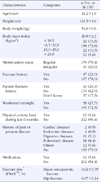Abstract
Purpose
This study described female college students' knowledge, self-efficacy and health behaviors related to bone health.
Methods
A descriptive cross-sectional survey design was used. A total of 214 students were conveniently recruited from a school of nursing in Korea. Participants (mean age=21.2, SD=1.9 years) bone mineral density (BMD) was measured using dual energy x-ray absorptionmetry. Participants also completed a questionnaire consisting of knowledge test, self-efficacy scale and health behaviors related to bone health. Data were analyzed using SPSS/WIN 17.0 program.
Results
The mean BMD at left femoral neck site was 0.86 g/cm2 and 6.1~12.6%. Results showed that participants were below the expected range of BMD. Level of knowledge (correct rate=54%) and self-efficacy were moderate (mean 54.8 out of 84). More than 84% of subjects drank alcohol more than once a month and 58.4% did participate in regular exercise. Only 7.9% participants took calcium and vitamin-D rich foods every day. There were significant positive correlations between knowledge and self-efficacy (r=.17), health behaviors (r=.14) and self-efficacy and health behaviors (r=.28, all p<.05).
Figures and Tables
References
1. Cho D.S., Lee J.Y. Bone mineral density and factors affecting in female college students. Korean Journal of Women Health Nursing. 2008. 14:297–305.

2. Choi E.S., Lee J.Y. A study on the level of awareness and self-efficacy of osteoporosis in young women. Korean Journal of Women Health Nursing. 2010. 16:204–214.

3. Choi H.J., Lee C.D., Cho J.H., Kim H.J., Shin M.R., Lee J.H., et al. Association between bone mineral density and health-related physical fitness test components. Korean Journal of Sports Science. 2006. 15:625–632.
4. Cummings S.R., Melton L.J. Epidemiology and outcomes of osteoporotic fractures. Lancet. 2002. 359:1761–1767.

5. Fujiwara S., Nakamura T., Orimo H., Hosoi T., Gorai I., Oden A., et al. Development and application of a Japanese model of the WHO fracture risk assessment tool (FRAX). Osteoporosis International. 2008. 19:429–435.

6. Horan M.L., Kim K.K., Gendler P., Froman R.D., Patel M.D. Development and evaluation of the osteoporosis self-efficacy scale. Research in Nursing & Health. 1998. 21:395–403.

7. Iki M., Kagamimori S., Kagawa Y., Matsuzaki T., Yoneshima H., Marumo F. Bone mineral density of the spine, hip and distal forearm in representative samples of the Japanese female population: Japanese population-based osteoporosis (JPOS) study. Osteoporosis International. 2001. 12:529–537.

8. Jeong H.R., Yun S.J., Kim M.H. Evaluation of food and nutrition intake by food questionnaire between normal and risk groups according to the bone mineral density of female college student residing in Gangwon area. Korean Journal of Community Nutrition. 2010. 15:429–444.
9. Jung G.H., Yang S.O., Lee K.O., Pye O.J., Lee M., Baik S.H., et al. Bone mineral density, health-promoting behaviors, and self-efficacy in middle-aged women. Korean Journal of Women Health Nursing. 2003. 9:170–178.
10. Kanis J.A., Johnell O., Oden A., Johansson H., McCloskey E. FRAX and the assessment of fracture probability in men and women from the UK. Osteoporosis International. 2008. 19:385–397.

11. Kim H.J., Kim M.S. A study on the relationships between knowledge about osteoporosis and cognitive factors in middle-aged women. Korean Journal of Women Health Nursing. 2005. 11:52–57.

12. Kim M.S., Koo J.O. Comparative analysis of food habits and bone density risk factors between normal and risk women living in the Seoul area. Korean Journal of Community Nutrition. 2008. 13:125–133.
13. Kim S.C., Kwon D.M. The relation between a practical life and a bone mineral density for college student. Journal of Radiological Science and Technology. 2005. 28:235–239.
14. National Health Statistics; 2008, The 3rd Korea National Health and Nutrition Examination Survey (KNHANES III). Korea Centers for Disease Control and Prevention. 2008. 03. Retrieved May 8, 2011. from http://knhanes.cdc.go.kr.
15. National Health Statistics; 3rd year (2009) The 4th Korea N ational Health and Nutrition Examination Survey (KNHA NES IV). Korea Centers for Disease Control and Prevention. 2009. 03. Retrieved April 4, 2011. from http://knhanes.cdc.go.kr.
16. Lee E.N., Son H.M. Discriminating factors of stage of change in bone mass promoting behaviors after bone mineral densitometry. Korean Journal of Adult Nursing. 2007. 19:389–400.
17. Magee J.A., Stuberg W.A., Schmutte G.T. Bone health knowledge, self-efficacy, and behaviors in adolescent females. Pediatric Physical Therapy. 2008. 20:160–166.

18. Min H.J., Oh H.Y. A study on osteoporosis knowledge, health beliefs and health behaviors among female college student. Journal of Korean Academy of Community Health Nursing. 2011. 22:111–120.
19. Results of the 3rd Korea National Health and Nutrition Examination Survey (KNHA NES III). Ministry of Health and Welfare. 2005. Retrieved September 6, 2010. from http://www.kostat.go.kr.
20. National Osteoporosis Foundation. Clinician's guide to prevention and treatment of osteoporosis. 2010. Washington, DC: Author.
21. Park N.J. The effect of running exercise on bone mineral density, physical fitness in young women students. 2003. Gwangju: Chonnam National University;Unpublished doctoral dissertation.
22. Piaseu N., Schepp K., Belza B. Causal analysis of exercise and calcium intake behaviors for osteoporosis prevention among young women in Thailand. Health Care for Women International. 2002. 23:364–376.

23. Schmiege S.J., Aiken L.S., Sander J.L., Gerend M.A. Osteoporosis prevention among young women: Psychosocial models of calcium consumption and weight-bearing exercise. Health Psychology. 2007. 26:577–587.

24. Sun K.S. The effect of web-based osteoporosis prevention program on the osteoporosis knowledge, self efficacy, health belief, stage of change in female college students. 2003. Kwangju: Chonnam National University;Unpublished master's thesis.
25. The International Society for Clinical Densitometry. Diagnosis of osteoporosis in men, premenopausal women, and children. Journal of Clinical Densitometry. 2004. 7:17–26.
26. The Korean Nutrition Society. Dietary reference intakes for Koreans. 2010. Seoul: The Korean Nutrition Society.
27. The Korean Society of Bone Metabolism. Physician's guide for diagnosis and treatment of osteoporosis. 2008. Seoul: Author.
28. Wallace L.S. Osteoporosis prevention in college women: Application of the expanded health belief model. American Journal of Health Behavior. 2002. 26:163–172.

29. Waller J., Eriksson O., Foldevi M., Kronhed A.G., Larsson L., Lfman O., et al. Knowledge of osteoporosis in a Swedish municipality - a prospective study. Preventive Medicine. 2002. 34:485–491.




 PDF
PDF ePub
ePub Citation
Citation Print
Print








 XML Download
XML Download